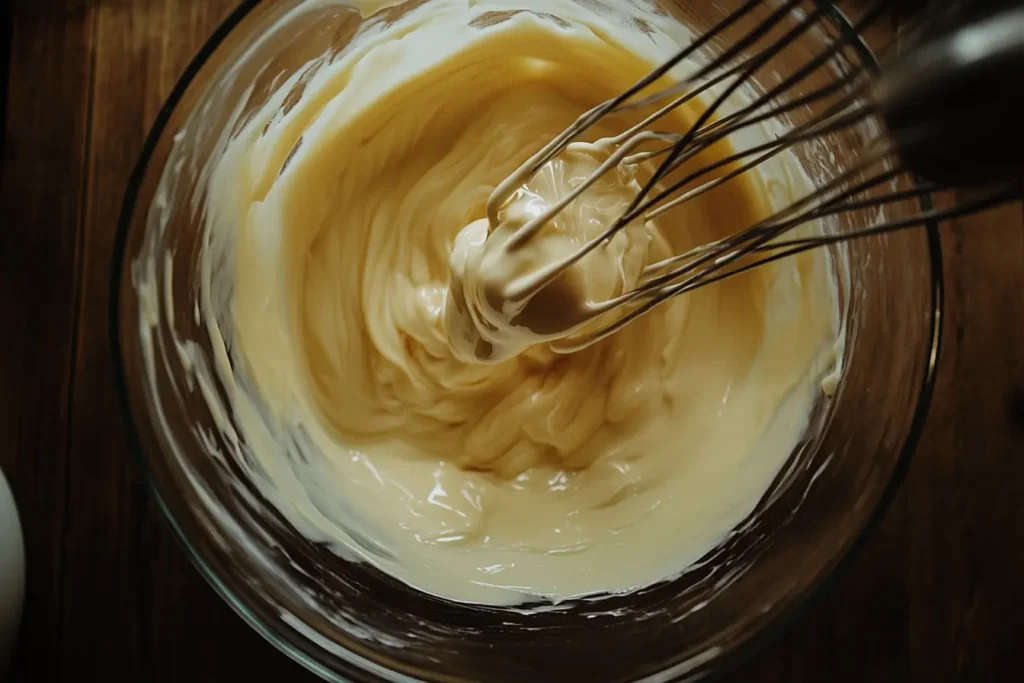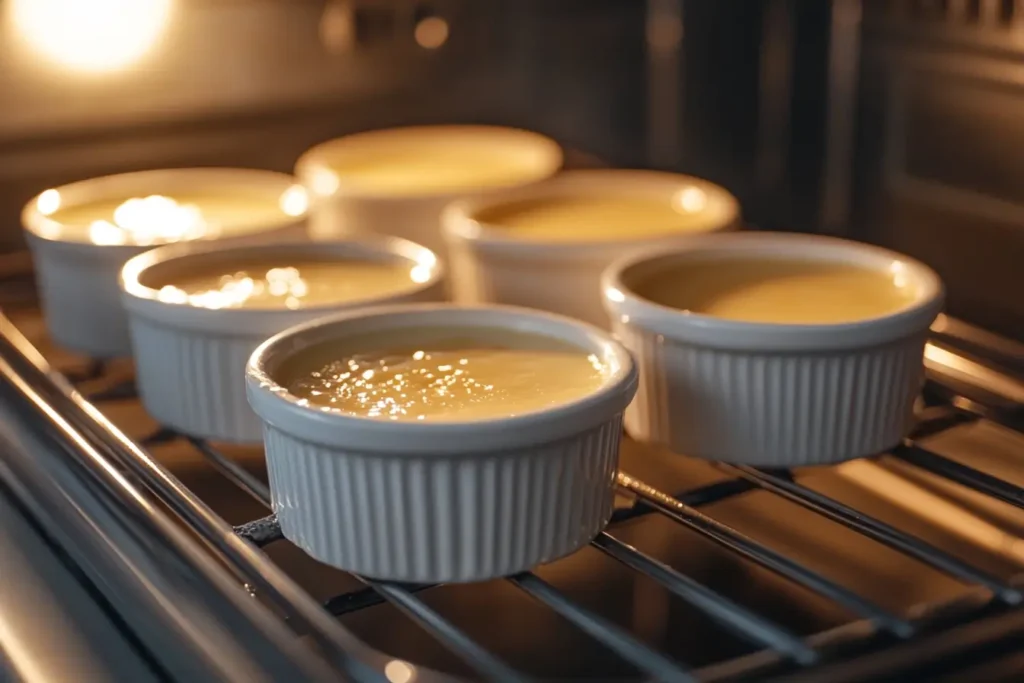Crème brûlée is one of those desserts that feels like a little piece of culinary magic. With its creamy custard base and a glass-like caramelized sugar topping, it’s a favorite in both high-end restaurants and cozy kitchens worldwide. But have you ever stopped to wonder, what is crème brûlée made of? Surprisingly, this luxurious treat is crafted with just a few simple ingredients, yet each one plays a vital role.
In this article, we’ll explore the classic components, delve into its history, uncover the techniques for perfect preparation, and even look at some creative variations. Whether you’re a seasoned chef or a curious foodie, this guide will give you everything you need to know about this timeless dessert. Let’s dive into the delicious world of crème brûlée!
Introduction to Crème Brûlée
What is Crème Brûlée Made Of?
Crème brûlée, a traditional French dessert meaning “burnt cream,” is a timeless classic that combines a velvety custard base with a crisp, caramelized sugar topping, offering a delightful contrast of creamy and crackly textures. While traditionally flavored with vanilla, this elegant dessert has evolved over time, inspiring modern variations with citrus zest, warm spices, or infusions of coffee and chocolate. Despite these creative twists, crème brûlée remains a celebration of simplicity transformed into art, proving how basic ingredients like cream, sugar, and eggs can create something truly extraordinary.
Origin and History of Crème Brûlée
The origins of crème brûlée are as rich as its flavor. While it’s now a quintessential French dessert, there’s a fascinating debate about its true birthplace. Some credit France for its refinement, while others point to England or even Spain as its originators. It first appeared in 1691 in a French cookbook by François Massialot, described as “crème à l’Angloise.” Regardless of where it began, crème brûlée evolved over centuries, gracing royal feasts before finding its way into modern kitchens.
Evolution of the Recipe Over Time
Over the years, crème brûlée has naturally evolved, undergoing slight tweaks to suit varying tastes and cultural influences. While traditionally flavored with vanilla, modern adaptations have embraced a world of creativity. For instance, some recipes incorporate a hint of citrus zest to brighten the custard’s richness, while others venture into more adventurous territory by introducing exotic spices like cardamom or even lavender. As a result, this classic dessert continues to captivate, offering a fresh twist while staying true to its timeless roots. However, the essential ingredients and techniques have remained remarkably unchanged, preserving the dessert’s timeless appeal. This combination of tradition and creativity ensures its place in the culinary hall of fame.
Core Ingredients of Crème Brûlée
Ingredients for Classic Crème Brûlée
- Heavy cream: 2 cups (480 ml)
- Egg yolks: 5 large
- Granulated sugar: ½ cup (100 g), plus extra for topping
- Vanilla bean: 1, or 2 teaspoons of vanilla extract
- Salt: A pinch
Essential Components of Traditional Crème Brûlée
At its core, crème brûlée is a masterpiece built from a few humble ingredients. The magic unfolds in their simplicity, as each one plays a crucial role in creating the dessert’s signature flavor and texture. First, heavy cream provides the luxurious richness that defines the creamy base. Then, egg yolks lend their silky, custard-like consistency, while sugar and vanilla weave in sweetness and warmth. Finally, this indulgent base is crowned with a perfectly caramelized sugar crust, offering a delightful crackle that contrasts beautifully with the smooth custard beneath.Let’s break down these essential ingredients and explore why they matter so much.
Role of Heavy Cream in Texture and Flavor
Heavy cream is the backbone of crème brûlée. It provides the luscious, velvety texture that sets this dessert apart from other custards. When heated and combined with other ingredients, it creates a silky consistency that’s both rich and indulgent. The cream also helps balance the sweetness, making each bite smooth and satisfying. For those looking to experiment, some chefs blend half-and-half or milk with cream, but the results may not be as luxurious.
Importance of Egg Yolks in Custard Formation
The custard’s creamy body owes much of its structure to egg yolks. These golden gems act as a natural thickener when whisked with sugar and heated. The yolks create a smooth, cohesive mixture that sets into a perfectly wobbly custard during baking. Using fresh, high-quality eggs can elevate the flavor and ensure a vibrant, appetizing color.
Sweetening with Sugar: Balancing the Taste
Sugar is both a sweetener and a key player in the dessert’s texture. In the custard, sugar dissolves into the cream and eggs, enhancing the flavor without overwhelming it. The magic happens when sugar is sprinkled on top and torched or broiled. The heat transforms it into a crackling caramelized layer, providing that delightful crunch synonymous with crème brûlée.
Vanilla: The Classic Flavoring Agent
Vanilla is the heart of traditional crème brûlée, infusing it with a warm, aromatic sweetness. Whether you use vanilla beans, extract, or paste, its presence elevates the dessert from simple to sublime. For an authentic touch, many recipes recommend scraping seeds from a vanilla pod into the cream, giving the custard a speckled appearance and enhancing its flavor profile.
Preparation Techniques
Step-by-Step Guide to Making Crème Brûlée
Making crème brûlée may seem intimidating, but it’s surprisingly straightforward once you break it into manageable steps. With attention to detail, a few simple tools, and a little patience, anyone can master this classic dessert. Below is a detailed step-by-step guide to help you achieve custard perfection, complete with tips to ensure a creamy custard base and a beautifully caramelized sugar topping.
Mixing the Custard Base

Start by whisking the egg yolks and sugar in a bowl until the mixture is pale, creamy, and smooth. Gradually add the warm heavy cream in a slow stream while whisking constantly to temper the eggs and prevent curdling. The slow addition helps maintain a uniform texture and prevents any lumps from forming. Once combined, stir in the vanilla for that classic flavor. Finally, strain the mixture through a fine mesh sieve to remove any impurities, ensuring a silky, uniform custard base.
Baking in a Water Bath: Ensuring Even Cooking

The secret to perfectly cooked crème brûlée lies in the water bath, or bain-marie. This gentle cooking method creates a protective environment for the custard, preventing it from overheating or curdling. To set it up, place the ramekins in a larger, deep baking dish, and carefully pour hot water into the dish until it reaches halfway up the sides of the ramekins. The water’s heat distributes evenly, allowing the custard to cook at a steady, controlled temperature.
Bake the custards until the edges are firm but the center jiggles slightly when shaken. Avoid overbaking to maintain a silky texture. Once done, remove from the water bath, cool, and chill.
Achieving the Perfect Caramelized Sugar Topping
The caramelized sugar topping is where the magic happens. Once the custard has cooled, sprinkle an even layer of sugar on top. Use a kitchen torch to melt the sugar until it turns golden brown and forms a crackly shell. No torch? No problem! Broiling in the oven can achieve similar results, though careful monitoring is required to avoid burning. The key is to create a thin, even layer of sugar to ensure uniform caramelization. Allow the caramel to cool for a minute to harden before serving. The satisfying crack as you break through the crust is what makes crème brûlée so delightful!
Nutritional Information (Per 100g)
| Nutrient | Amount |
|---|---|
| Calories | 223 kcal |
| Total Fat | 17 g |
| Saturated Fat | 10 g |
| Cholesterol | 166 mg |
| Sodium | 35 mg |
| Total Carbohydrates | 16 g |
| Sugars | 15 g |
| Protein | 3 g |
Note: Nutritional values may vary slightly depending on specific ingredient brands and quantities used.
Variations and Modern Twists
Popular Variations of Crème Brûlée
Though traditional crème brûlée is a masterpiece on its own, modern chefs and home bakers have reimagined it with exciting variations. These twists breathe new life into the classic dessert, offering unique flavors and textures while staying true to its essence. From fruity infusions to decadent chocolate versions, there’s a crème brûlée for every palate.
Incorporating Different Flavors
Vanilla may be the classic choice, but crème brûlée shines with an array of flavor enhancements. Here are a few creative options:
- Chocolate Crème Brûlée: Add melted dark chocolate to the custard base for a rich, indulgent twist.
- Citrus Zest: Infuse the cream with orange, lemon, or lime zest for a refreshing tang.
- Lavender or Rosewater: Subtle floral notes can transform the dessert into a sensory delight.
- Coffee or Espresso: Mix brewed coffee or espresso into the custard for a bold, aromatic experience.
These flavors are often incorporated during the heating of the cream, allowing them to infuse deeply and complement the caramelized sugar topping.
Dietary Adaptations: Vegan and Gluten-Free Options
Crème brûlée can be tailored for dietary needs without compromising its essence. For a vegan version, coconut cream or cashew milk can replace heavy cream, while aquafaba or a plant-based egg substitute stands in for egg yolks. Additionally, since crème brûlée is naturally gluten-free, it’s already a safe choice for those avoiding gluten, as long as cross-contamination is avoided.
Experimenting with Toppings
Beyond caramelized sugar, the topping can also be a canvas for creativity. A sprinkle of coarse sea salt, crushed nuts, or a dusting of cocoa powder can add depth and contrast to the dessert. The possibilities are endless!
Serving and Pairing Suggestions
Ideal Serving Temperatures and Presentation
The beauty of crème brûlée isn’t just in its taste but also in its presentation. It’s best served slightly chilled, allowing the custard to firm up while the topping remains crisp. The interplay of cold custard and warm, caramelized sugar makes every bite a textural treat.
For an elevated presentation:
- Use individual ramekins for an elegant, portion-controlled dessert.
- Garnish with fresh berries, mint leaves, or edible flowers for a pop of color.
- Place ramekins on decorative plates with a drizzle of fruit coulis or a sprinkle of powdered sugar to impress guests.
Pairing Crème Brûlée with Wines and Beverages
Pairing the right drink with crème brûlée enhances its flavors and elevates the dining experience. Here are some ideal pairings:
- Sweet Dessert Wines: Sauternes, late-harvest Riesling, or Muscat highlight the dessert’s creamy sweetness.
- Coffee or Espresso: The bitterness of coffee balances the richness of the custard.
- Champagne: Its light, bubbly profile cuts through the dessert’s density, offering a refreshing contrast.
For a non-alcoholic option, herbal teas like chamomile or mint can complement crème brûlée’s delicate flavors beautifully.
Frequently Asked Questions About Crème Brûlée
Can Crème Brûlée Be Made Without a Torch?
Yes, crème brûlée can be made without a torch! While a torch is the traditional method for achieving that perfectly caramelized sugar topping, your oven’s broiler can work just as well. Simply place the ramekins under the broiler and watch carefully until the sugar melts and browns. Just be cautious—it can burn quickly, so don’t walk away!
How Long Can Crème Brûlée Be Stored?
Crème brûlée can be stored in the refrigerator for up to 2-3 days, but it’s best enjoyed within the first day for optimal flavor and texture. To maintain the crisp sugar topping, store the custards without caramelizing them, and add the sugar layer just before serving. Once caramelized, the topping may soften over time in the fridge.
What is the Difference Between Crème Brûlée and Crème Caramel?
Though similar in appearance, crème brûlée and crème caramel are distinct desserts. Crème caramel has a syrupy caramel topping, while crème brûlée features a hard, caramelized sugar crust. Additionally, crème caramel is inverted when served, showcasing the liquid caramel, whereas crème brûlée is served upright in its ramekin.
Can I Use Alternatives to Vanilla in Crème Brûlée?
Absolutely! While vanilla is the traditional flavoring, you can use almond extract, cinnamon, cardamom, or even liqueurs like Grand Marnier or Amaretto. These alternatives add a unique twist while preserving the dessert’s creamy character.
Why is My Crème Brûlée Runny?
A runny custard is often the result of undercooking or incorrect proportions of ingredients. Ensure that the custard sets by baking it in a water bath at the right temperature (usually 300–325°F). The custard should jiggle slightly in the center but firm up as it cools.
What’s the Best Way to Ensure Even Caramelization?
To ensure even caramelization, spread the sugar layer thinly and evenly. Using a fine sugar granule helps it melt uniformly under the torch or broiler. For extra precision, rotate the ramekin while torching to avoid scorching any single spot.
Conclusion
Crème brûlée is a testament to the beauty of simplicity, combining humble ingredients like heavy cream, egg yolks, and sugar into a luxurious dessert that delights the senses. From its rich history to its modern variations, this timeless treat continues to inspire creativity in kitchens worldwide. Whether you enjoy it as a classic vanilla custard or experiment with bold new flavors, crème brûlée’s appeal lies in its perfect balance of creamy and crunchy textures.
Now that you know what crème brûlée is made of and the techniques to create it, why not try making your own? With patience, attention to detail, and a touch of flair, you can bring this elegant dessert to life and impress anyone lucky enough to take a bite. Bon appétit!


2 thoughts on “What is Crème Brûlée Made Of? A Complete Guide to Ingredients and Preparation”